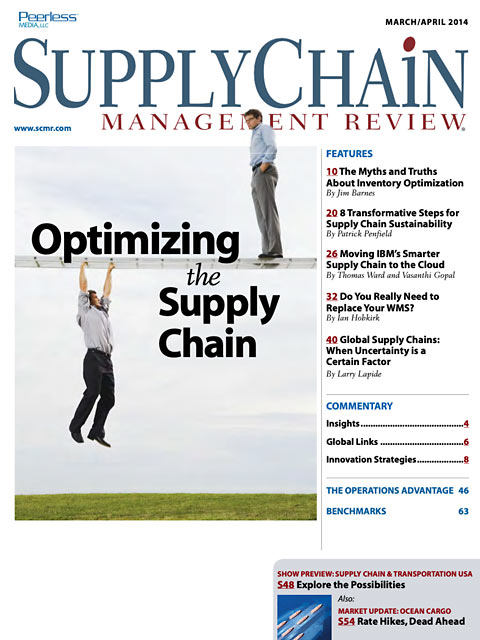Sorry, but your login has failed. Please recheck your login information and resubmit. If your subscription has expired, renew here.
March-April 2014
Retailers and distributors alike have attempted to solve their inventory challenges by using forecasting tools to determine what to buy and when to buy it. A better approach is to change the flow of inventory by reducing cycle times, more effective inventory positioning, and synchronizing supply chains based on the variability of demand. Browse this issue archive.Need Help? Contact customer service 847-559-7581 More options
Picture this: One day, you see your neighbor Bob carrying in a bunch of packages that UPS has just delivered to his house. Bob has always been a bit of an odd fellow. For one thing, he’s the only person you know who still heats his house with coal. One cold morning, he’s outside shoveling coal into an ancient hopper before the sun comes up. When you ask him what all the packages are for, he explains that it is so expensive and risky to replace his coal heating system, that he’s purchased a bunch of space heaters, electric blankets, and cashmere scarves to keep his family warm through the winter.
Sound a little crazy? Perhaps. But the situation is analogous to something that has been occurring in American distribution centers for years as companies go to great lengths to avoid replacing their aging warehouse management software (WMS) systems.
Structural changes to supply chains and demand patterns over the last two decades have created a host of new process requirements for distribution centers. Many companies’ WMS systems have failed to keep abreast of these new requirements, creating operational inefficiencies that eat away at corporate profits. Despite the benefits of upgrading to more modern supply chain software, many firms have resisted the call, and instead have sought less expansive solutions to address their needs. However, several technological advances, which have roots in the 1990s, have finally come of age and are offering alternatives to wholesale platform replacements.
 |
This complete article is available to subscribers
only. Click on Log In Now at the top of this article for full access. Or, Start your PLUS+ subscription for instant access. |
Not ready to subscribe, but need this article?
Buy the complete article now. Only $20.00. Instant PDF Download.
Access the complete issue of Supply Chain Management Review magazine featuring
this article including every word, chart and table exactly as it appeared in the magazine.
SC
MR
Sorry, but your login has failed. Please recheck your login information and resubmit. If your subscription has expired, renew here.
March-April 2014
Retailers and distributors alike have attempted to solve their inventory challenges by using forecasting tools to determine what to buy and when to buy it. A better approach is to change the flow of inventory by… Browse this issue archive. Access your online digital edition. Download a PDF file of the March-April 2014 issue.
 |
Download Article PDF |
Picture this: One day, you see your neighbor Bob carrying in a bunch of packages that UPS has just delivered to his house. Bob has always been a bit of an odd fellow. For one thing, he’s the only person you know who still heats his house with coal. One cold morning, he’s outside shoveling coal into an ancient hopper before the sun comes up. When you ask him what all the packages are for, he explains that it is so expensive and risky to replace his coal heating system, that he’s purchased a bunch of space heaters, electric blankets, and cashmere scarves to keep his family warm through the winter.
Sound a little crazy? Perhaps. But the situation is analogous to something that has been occurring in American distribution centers for years as companies go to great lengths to avoid replacing their aging warehouse management software (WMS) systems.
Structural changes to supply chains and demand patterns over the last two decades have created a host of new process requirements for distribution centers. Many companies’ WMS systems have failed to keep abreast of these new requirements, creating operational inefficiencies that eat away at corporate profits. Despite the benefits of upgrading to more modern supply chain software, many firms have resisted the call, and instead have sought less expansive solutions to address their needs. However, several technological advances, which have roots in the 1990s, have finally come of age and are offering alternatives to wholesale platform replacements.
 |
SUBSCRIBERS: Click here to download PDF of the full article. |
SC
MR

Latest Supply Chain News
- Technology’s role in mending supply chain fragility after recent disruptions
- Tech investments bring revenue increases, survey finds
- Survey reveals strategies for addressing supply chain, logistics labor shortages
- Israel, Ukraine aid package to increase pressure on aerospace and defense supply chains
- How CPG brands can deliver on supplier diversity promises
- More News
Latest Resources

 Explore
Explore
Topics
Latest Supply Chain News
- Technology’s role in mending supply chain fragility after recent disruptions
- Tech investments bring revenue increases, survey finds
- Survey reveals strategies for addressing supply chain, logistics labor shortages
- Israel, Ukraine aid package to increase pressure on aerospace and defense supply chains
- How CPG brands can deliver on supplier diversity promises
- How S&OP provides the answer to in-demand products
- More latest news
Latest Resources

Subscribe

Supply Chain Management Review delivers the best industry content.

Editors’ Picks





